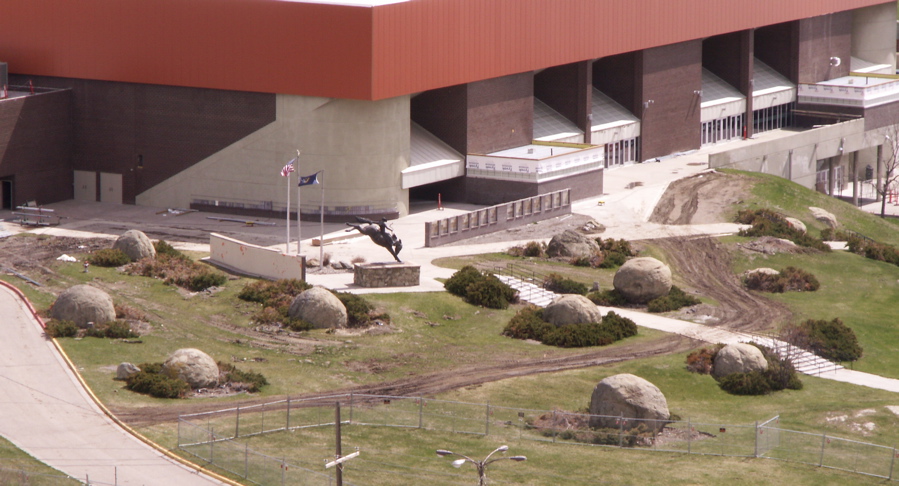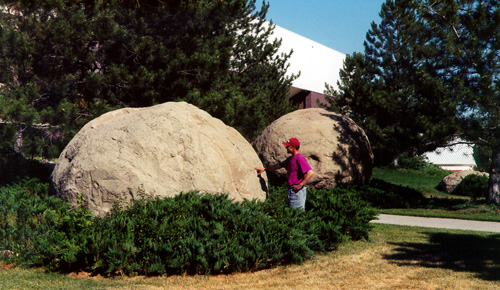|
They're called
"concretions." 
Photo taken in April 2011: It was still under repair from the tornado of June 2011. (more recent photo)
The Metra (MetraPark Rimrock Auto Arena). . .
The photo above was taken from the Rimrocks, looking across Main Street in Billings. It shows the strange spherical sandstone boulders around the Rimrock Auto Arena in Billings . . . better known as "The Metra". The Metra is popular venue for state basketball tournaments, the all-class wrestling tournament, concerts, rodeos, arena football games, hockey games,
etc. As crews began preparing the site for
construction in the mid-1970s, they came
upon several unusual, large sandstone
spheres, including the ones in the photo.
Rather than breaking them up and hauling
them away, they decided to incorporate them into the landscaping. Below: This photo was taken several years ago. The tornado removed several of these trees.
The other two photos on this page were taken in April 2011.

Natural Cements . . .
The unique spherical stones are a type of rock that
geologists call "concretions", and their
formation has to do with a variation in the type
of cement that holds the sandstone together.
In order for sand to become stone, the grains
of sand must be cemented together. Minerals
dissolved in groundwater typically do the trick.
Calcite (calcium carbonate) is the most
common cement for sandstone. But, since
calcite can be dissolved by rainwater,
sandstone is eroded away fairly easily.
However, with the sandstone that concretions
are made of the cement is not calcite, but
rather a more durable iron compound. The Metra concretions are exceptionally large - most are much smaller (photo). Not that kind of "precipitation" . . .
Concretions form as a result of some mineral (iron carbonate) dissolved in groundwater moving through the buried sediment. The mineral is precipitated in the pore spaces among the grains of sand. The precipitation may begin around a particular grain or fragment in the rock, such as a leaf, shell, bone, or other fossil, or a mineral grain such as calcite (short YouTube explanation). As the deposition of iron compound grows around this nucleus, you have the makings of a concretion; a spherical area within a layer of sandstone where the sandstone is tougher because it has been cemented with an iron compound, rather than calcite (see "source" below). When the iron-cemented rock is exposed to air the iron oxidizes, giving the concretion a rust-color that contrasts with the lighter-colored sandstone that it is embedded in (photos). As the weaker sandstone around it wears away, the sphere resists erosion. CLICK HERE to see another concretion located in the Rimrocks above the west side of Billings. Watch this short slide presentation to see how concretions appear on the surface.Below: The arrow points to the rock I am standing next to in the previous photo. The photo at the top of the page and the one below were both taken in April 2011. A tornado swept over the Metra in June of 2010, removing many of the trees. Although the Metra hosted an Elton John concert in April of 2011, construction crews were still working on the lobby area at the time the top and bottom photos were taken.

Term: precipitation (as it is used in the explanation above)
Source:
Magnificent Journey: A Geologic River Trip with Lewis and Clark through the Upper Missouri River Breaks National Monument" by Otto Schumacher and Lee Woodward
|








